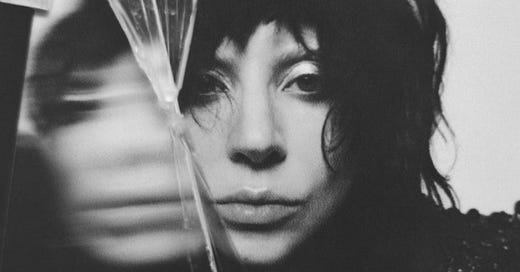Album Review: Lady Gaga 'Mayhem'
After nearly half a decade, Gaga returns to pop, and progressively hearkens back to her previous selves.
On first listen, Lady Gaga’s Mayhem was not what I expected. The intense, charged lead singles “Disease” and “Abracadabra” and their chaotic, well-choreographed music videos made it seem like Mayhem was on track to travel back to 2009 and recall the fantastic gothic electropop of The Fame Monster. Instead, Mayhem also refers to the musical makeup of this body of work. Flourishes of Gagas past converge and contort over these productions that range from funky to grungy and result in a set of tracks that aren’t entirely cohesive, but possess the potential to rank among her best in the long run. Impressively, she executes these mutations without sounding repetitive, scattered, or as if she’s going in reverse. Mayhem has just enough recall to please the nostalgics, but progressively pushes and pulls in different directions, without being disjointed.
With each listen, those flourishes of Gagas past peak through in every facet of the songs, often subtly; productions, melodies, deliveries, and instruments all momentarily hearken back to her non-jazz LPs.
After Mayhem opens with the one-two punch of its lead singles, things take a decisive turn with her next two cuts. “Garden Of Eden”’s dance floor rendezvous nods not just to ARTPOP (“Manicure), but also flourishes of The Fame, as well as other early 2010’s pop sounds, including Britney Spears’ “Piece of Me” and “Kill The Lights.” She erupts with rage as she reflects on the push and pull of her status on the grungy “Perfect Celebrity.” “You love to hate me, I’m the perfect celebrity!” she growls over the cut, which was also a working title for the album. There’s even a lyrical nod to one of the most popular unreleased Gaga cuts, “Princess Die.”
She’s at her best all-around on the driving, progressive, edgy funk of “Vanish Into You,” which musically gives a slight nod to ARTPOP’s “Fashion!” in its piano. It’s fantastically steeped in the melancholy of nostalgia, with a killer 1-2 punch of pre-chorus and chorus that are irresistible as she clamors to disappear into a picture depicting a brighter moment in the relationship.
The same goes for “Don’t Call Tonight,” which roots itself firmly in 80’s electro sounds, while topically reaching all the way back to the classic 1960 Goffin-King composition performed by The Shirelles, “Will You Still Love Me Tomorrow?” “Don’t call tonight, unless you want to hurt me,” Gaga pleads on the unstoppable hook, clearly already knowing the answer to The Shirelles age-old question. having found out that he not only won’t still love her tomorrow, he’ll cause her pain.
“How Bad Do U Want Me” is a solid track that nearly measures up. It revolves around Carly Rae Jepsen-esque 2010’s synthpop and even flourishes of the ill-conceived ARTPOP R. Kelly duet, “Do What U Want.” It comes close to “Vanish” and “Tonight,” but foils itself with one flub: Echoed “me’”s that emphasize the “e”’s end up sounding like they’re performed by Family Guy’s Peter Griffin, launching an otherwise fantastic ode to longing into absurdity.
As she nods to her previous selves she continuously finds herself on haunting and spooky ground. Unlike previous works though, the spooky stuff here is largely cloaked in a funky, Halloween party music vibe. Take the glittery disco funk ode to her “Zombieboy.” It opens with a “Hollaback Girl”-esque school spirit chant and could bridge together classics like “Monster Mash” and Kim Petras’ “Close Your Eyes” on a Halloween playlist. Bonus track “Kill For Love” has a similar funky-yet-spooky vibe, but is more evocative of Michael Jackson’s “Thriller.”
The album’s one skip, “The Beast,” takes a different approach to the spookiness. Instead of funk and disco, it uses synthy, 80’s percussion that recalls Phil Collins’ “In The Air Tonight” as her vocals create an anticipation and even yearning for unleashing of “the beast inside.” But instead of a beat showing up, the pre-chorus (which then becomes a repeated bridge) of “you can’t hide who you are, 11:59,” comes off sounding like something 30 Rock’s Jenna Maroney would sing.
The other place Mayhem runs into trouble is with its two bonus tracks, which are both fantastic additions to the album. The problem is that the bonus tracks are exclusive to different pressings and sequenced differently into the album; meaning no pressing of the album contains all 16 tracks. Pressings exclusive to Gaga’s website and Japan offer the bombastic, grungy “Can’t Stop The High,” whose post-chorus and refrain have a slight flourish of “Born This Way” in the melody. Target (which is currently enduring a boycott for abandoning practices to support the LGBTQ+ audience Gaga thrives on) and HMV offer the aforementioned “Kill For Love.” This confusion is unnecessary and reeks of trying to squeeze every sale possible out of her fan base (not to mention frustrating completists like myself who aim to physically own the entire album).
Despite those misgivings, Mayhem brings things to a close on two strong notes: The album’s big power ballad, “Blade of Grass,” and the Grammy-winning, #1 duet with Bruno Mars, “Die With A Smile,” which this critic managed to avoid until Mayhem hit the net. They do a fantastic job of tying together this unexpected, yet well-crafted addition to the Lady Gaga canon.




